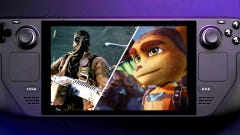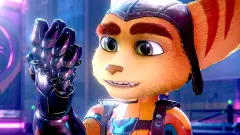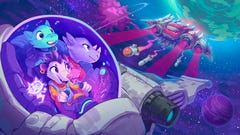Ratchet and Clank: Rift Apart review - cracking, unserious action
Portal combat.
That Insomniac lot are a bit good at this, aren't they? This is a studio that has a thing, and is very good at it. That thing is crunchy action, springy movement, a kind of intangible elasticity of motion. It's playfulness. The team's boiled it down to a formula now - formulas can be good things too by the way - and so they can now inject it with precision into everything they make, from Sunset Overdrive to Spider-Man to of course Ratchet and Clank.
Ratchet and Clank: Rift Apart is the latest and it's a treat; featherlight and welcoming, almost completely on rails - sometimes literally - but in a way that just makes playing it a breeze. Mild peril, low to no stakes, a kind and thoughtful heart, a fairly large amount of Nickelodeon jokes that might've washed over me but will no doubt split the sides of your seven-year-old. A blast. This is what Insomniac does so very well: makes games full of charm, movement full of whip and snap, animation full of life.
Here's the setup: Ratchet is a furry creature called a Lombax, lonely and one-ish of a kind, his sidekick Clank is a little robot, and the two of you are heroes. As a gift, on an opening day that has the two of you float through your own victory parade, Clank has made Ratchet a Dimensionator, an old macguffin that can open up portals to different dimensions. But - surprise! - things go sour when the nominatively-determined Dr. Nefarious turns up and pilfers it, travelling to a dimension where he always wins. And we're off. The rest of the plot's a little thin (lots of that payoff can-kicking, "At last, we finally have everything we need to buil- Oh no! The machine's broken!" kind of thing, which can make events feel a touch more overlong than they actually are) but the plot is very much not the point.
What is the point is the Insomniac delivery, the story, which is a simple, mushy delight. In one alternate dimension is another Lombax, called Rivet, and another little robot sidekick, called Kit, and without knowing it the two share a sweet, redemptive arc that's built on forgiveness and growth. Ratchet and Clank are separated early on, and it makes for a tidy switcheroo: Clank loses an arm and must come to terms with it, pairing up with the empowered Rivet, who uses a prosthetic arm of her own and for the most part already has. Some ever-so-slightly mechanical therapy speak will go over the heads of younger players, but the point is it's a good story, a kind one, and so one you'll want those kids to listen to, whether they follow all the nuances or not.

Rivet herself is ace, playing more or less identically to Ratchet - she is an alternate universe him, after all - but she's a smidge more likeable. She's wittier and brighter, reliably dropping a cutting "huh?" face whenever Nefarious waffles. There is also a whiff of Marvel Cinematic Universe about the whole thing, too, what with the alt-dimension versions of other familiar faces that pop up here and there, and how Rivet gets her 'origin story' delivered through another's journey, very deliberately laying the foundations for a standalone one of her own (surely).
Planets are split evenly between the two heroes, and hopping between them is arguably the core of Rift Apart. Each one's structured like a PS2 era gem: miniature open worlds sprinkled with collectibles and resources. Most important is Raritanium, which goes towards upgrading your weapons, and works as a perfect, incentivising carrot to drag you into exploration. There are some optional side quests on some - meeting some oddly-voiced character or other to collect X plants or Y ingredients - but the reality is it's all incredibly simple, even shallow, but the charm of it and the sheer amount of money-on-screen fidelity makes the simplicity a strength.
Each of these planets builds to an Uncharted-like, action-platforming climax: the sequence with The Fixer, a literal on-rails rollercoaster, feels like the best Disney World ride you've ever been on; another, about avoiding a roaming monster in an abandoned underwater facility, is all very Alien Isolation (a great primer for the kids - or fellow cowards). Again they're simple, breezy, largely linear and handled with the lightest touch but again that's the joy of it.
One thing that surprised me, a little, was the warping between worlds, which is a bit different to what you might've seen in trailers. The big, between-multiple-dimensions moments, where the hero's falling through the sky and the environment rapidly flicks from one to the next, only come in cutscenes. Most portals that you use in practise are actually like an instant grapple, a short-hop teleportation, basically, where you tap L1 at a pre-fixed portal and instantly pop out the other side. It is slightly, slightly, less impressive than repeatedly teleporting through entire worlds, but there's still a wonderful zip to it, a sense of whiplash to how the whole world zooms forwards over you like you just concertinaed space-time onto itself, the pencil-through-folded-paper approach of an actual wormhole.


There are a couple of exceptions to this very minor limitation, too, in "pocket dimensions", which are little bonus round zones you find tucked behind semi-hidden portals, and much more impressively in planets like Blizar, which have stationary crystals that you whack to instantly switch the environment to an alt-dimension version of the planet. This is where your traversal, which is often a minor puzzle, becomes just a bit more of a headscratcher at times - move this here, whack that crystal, jump back here, crystal again, and so on. At once Blizar is a purple, fractured void in space, chunks of planet floating about without atmosphere like it's had a good zap from the Death Star, and at the same time, instantly, it's a bustling, volcanic mining world full of people. Rift Apart's effectively giving you two worlds at once, but it's so casual about it all that it's easy to overlook. This really is a marvel, though, and makes for some of the best sections in the game.

The others, of course, revolve around the many moments of action. The exploration and the resource-hoovering is a sort of nostalgic by-product in Rift Apart, a passive activity you can do brain half-off, scooting about with one of the game's million different modes of travel. The action, meanwhile, is brain-full-on stuff. It's carnage, Insomniac doing that new console generation thing of throwing an obscene amount of objects, particles, pizzazz on the screen at once. Enemies, however mechanical the robot-pirates or nefarious drones may be, seem to burst like summer fruit before fading away vaporised. It makes combat feel like a celebration, a birthday party, as the little orange-domed heads pop or dino-skeleton bones explode apart like confetti, all amongst the most aggressive vividity of colour - purple rifts, electric blue skies, red lava, golden-brown stone.
It's paced beautifully, with what might be a teasing difficulty for youngsters - I played on normal and found it a breeze, especially after the villainous but oddly similar-in-kind Returnal (bullet-hell, jump-dashes, grappling hooks, disintegrating lasers, little shiny things that burst out of enemies and need collecting, big and oddly static bosses lurking just the other side of a ledge - I digress!), but there are moments, especially against bosses, where you'll run very tight on ammo even with a solid aim, and good movement and concentration will become more important. For adults it's exactly what you'll want, enough to suck you into a zen trance without ever forcing you to sit forwards in your chair.


The weapons themselves, as you'd expect, are a highlight amongst the highs. My favourites were the Topiary Sprinkler, which squirts water at nearby enemies and turns them into decoratively trimmed hedges, frozen in place; and Mr. Fungi, which is a mushroom that darts about annoying enemies like the floating pun that he is. Award for most effective goes to the shotgun, which has a wonderful half-pull trigger system where you can fire just one or both of the two barrels depending on how hard you squeeze. Least enjoyable is the ice cube one, which felt a bit redundant next to the funnier Topiary Sprinkler that served the same purpose, and the Headhunter, a fairly run-of-the-mill sharpshooter which, in what is at least partially a children's game, all felt a bit NRA-sponsored Nerf-gun to me - Baby's First Sniper Rifle - but then Fortnite and others normalised this a while ago, so maybe dad should get with the times. What matters most is they're fun.
All of this is paired with wonderful, kinetic motion. Ratchet and Rivet have a warehouse full of toys when it comes to movement - a result, maybe, of first-party Sony games' slightly magpie-like approach to mechanics (wall-running, for instance, barely feels necessary here, and see also the ubiquitous grappling hooks now, replacing the once-ubiquitous golden ledges). Jumping is a tad wafty, I found, making a very small number of platforming moments feel a touch fiddly or imprecise. The dash, similarly, is a wibbly-wobbly thing that seems to happen almost in slow motion, which feels slightly out of step with the frantic energy of combat and everything else, but yet again what works is the characterisation of it all, the life imbued into it by Insomniac - the wobbles of ears and tails, the cartwheels in the air, the handful of rapid spins you do round a yellow grappling thingy before you're fully launched, the warp speed of the rails, hover boots and mounts.
The exploration and the resource-hoovering is a sort of nostalgic by-product in Rift Apart, a passive activity you can do brain half-off... The action, meanwhile, is brain-full-on stuff.
A couple of other modes punctuate the action, minigames that are maybe the tiniest bit underworked on their own, but work as very welcome pauses to the usual carnage. One has Clank solving environmental puzzles in a metaphorical version of his own mind, where you must redirect your "possibilities" (little ghost Clanks that are effectively a stream of Lemmings) through various hazards. It's an odd but actually quite lovably laboured metaphor, working your thoughts through all logical paths until you find the right one, the answer to a problem, but the actual sequences themselves are just fine, tasking you with fetching balls and plonking them in certain slots to catapult your possible Lemmings over this chasm or that buzzsaw. A bit more fun, if stressful, are the "anti-virus" sections, where you play a shrill and deeply nervous crab-robot armed with the most satisfying machine gun of the game, climbing walls, going topsy-turvy around the little computer-chip world all while shooting literal virus-shaped blobs and overcoming imposter syndrome with great triumph. Sheesh!
This is it though, the character and the absurdity and the charm that Insomniac is all about, that the team kick-started with Ratchet and Clank in 2002 and continue to master with such faultless confidence in Rift Apart. It's just pure craft, pure fun, pure video games - all the brilliant, bizarre ideas this studio has just thrown at the wall and all of them sticking. The only thing it lacks - apart from maybe a tiny bit of restraint - is pretence. There's no self-seriousness, no po-faced melodrama, no insecurity about the form. A game that's happy to be a game, in a familiar, cuddly shape.
















